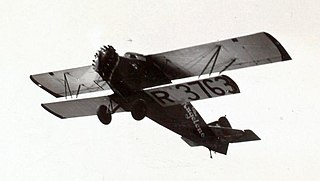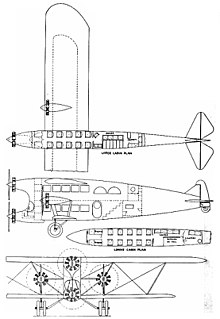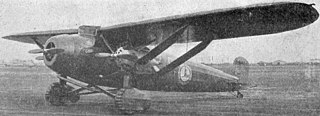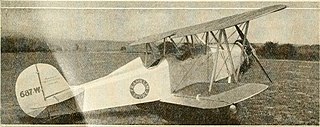
The Curtiss F7C Seahawk was a carrier-capable biplane fighter aircraft of the United States Navy Marine Corps in the late 1920s and early 1930s.

The Lockheed Air Express was the second aircraft design created by the Lockheed Aircraft Company after its founding in 1927; the type first flew in April 1928.

The PWS-24 was a Polish single-engine passenger aircraft for 4 passengers, built in PWS factory, used from 1933 to 1936 by LOT Polish Airlines. In spite of its limited capacity, it was the only series-built airliner of domestic design ever used by the LOT.

The Douglas O-2 was a 1920s American observation aircraft built by the Douglas Aircraft Company.

The Bellanca CH-400 Skyrocket is a six-seat utility aircraft built in the United States in the 1930s, a continuation of the design lineage that had started with the Bellanca WB-2. Retaining the same basic airframe of the preceding CH-200 and CH-300, the CH-400 was fitted with a more powerful Pratt & Whitney Wasp radial engine.

The Bellanca 31-40 Senior Pacemaker and its derivatives were a family of a six- and eight-seat utility aircraft built in the United States in the late 1930s. They were the final revision of the original late 1920s Wright-Bellanca WB-2 design. The model numbers used by Bellanca in this period reflected the wing area and engine horsepower, each divided by ten. Like their predecessors, these were high-wing braced monoplanes with conventional tailwheel undercarriage.

The Buhl AirSedan was a family of American civil cabin sesquiplane aircraft developed and manufactured by the Buhl Aircraft Company in the late 1920s. One example completed the first transcontinental non-stop roundtrip flight, made in 1929 by the CA-6 Spokane Sun-God, and the first Pope to have flown did so in a Buhl Airsedan.

The Bach Air Yacht was a trimotor airliner produced in the United States in the 1920s. Typical of its day, it was a high-wing braced monoplane, with fixed tailwheel undercarriage. Unusual for airliners of the late 1920s,, the Air Yachts were constructed almost entirely of wood with steel fittings, undercarriage and struts. Different models were powered by varying combinations of Wright, Ryan-Siemens, Kinner, Comet, and Pratt & Whitney engines, a large engine in the nose of the aircraft and two smaller "helpers" under the wings in nacelles supported by struts. As with so many aircraft companies of the late 1920s the Bach Aircraft Company succumbed to the Great Depression, thus further development of the Air Yacht was abandoned after the 3-CT-9.

The Hamilton H-45 and H-47 were six-passenger-seat, all-metal, high-wing monoplanes powered by single Pratt & Whitney radial engines. They were built for passenger and mail-carrying work in the US in the late 1920s.

The Boeing XPB was an American twin-engined biplane long-range patrol flying boat of the 1920s. A single example was built for the United States Navy.
The Thaden T-1 Argonaut was a 1920s American eight-seat all-metal cabin monoplane, built by the Thaden Metal Aircraft Company of San Francisco, California.

The Stearman LT-1 was a late 1920s American biplane, carrying four passengers plus mail.

The Waco E series is a small family of American-built cabin biplanes built between 1939 and 1942, which differed primarily by engine installation.
The Solar MS-1 was an American prototype all-metal sesquiplane airliner built in 1930.

The Bach "Super Transport" was a design for a four-engined transport aircraft that was never built.

The Emsco B-2 Challenger was a US three-engined, six passenger aircraft flown in 1929. Only two were built and they were quite soon converted into two different Emsco types, one with one engine and the other with two.

The Wallace Touroplane was a late 1920s U.S. three seat, high wing cabin monoplane. About 20 were built.

The Zenith Albatross Z-12 was a large, three-engined airliner built in the United States in 1928. It could carry up to 11 passengers. Only one was completed.

The Franklin Sport is a two seat sport and training biplane built in the U.S. in 1930. Several different engines, in the power range 55–90 hp (41–67 kW), were fitted. Two remained airworthy in 2011.

The Ireland Neptune was a four or five place pusher configuration biplane sold in flying boat and amphibian versions. Designed in the U.S. and first flown in 1927, well over 50 were built.



















